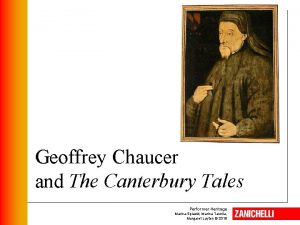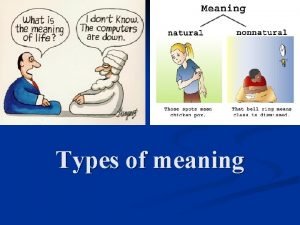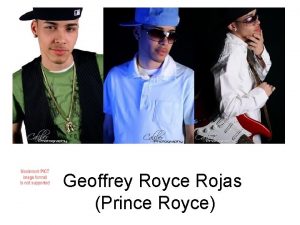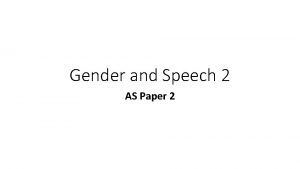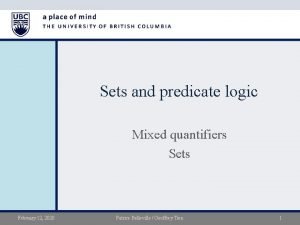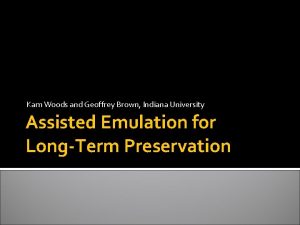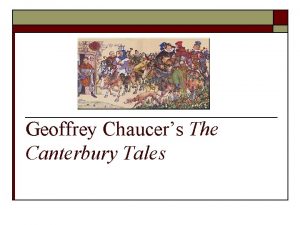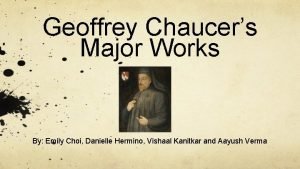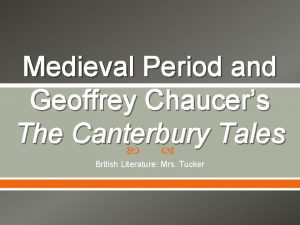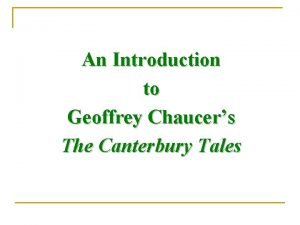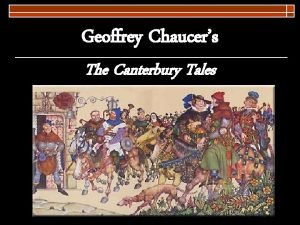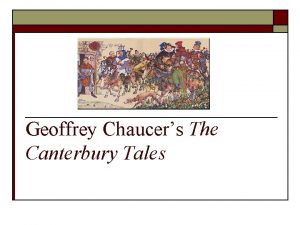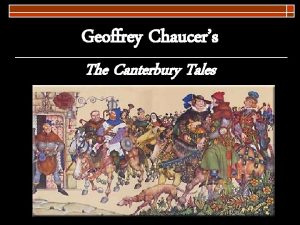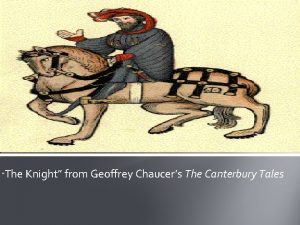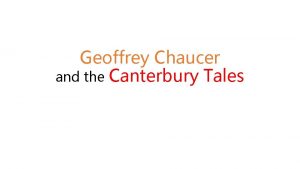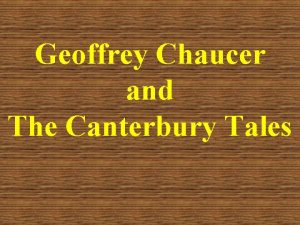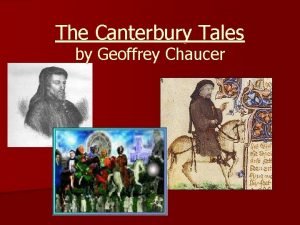English 4 Major English Writers Geoffrey Chaucers The
















- Slides: 16

English 4 Major English Writers Geoffrey Chaucer’s The Canterbury Tales: The General Prologue

Geoffrey Chaucer’s The Canterbury Tales: The General Prologue Geoffrey Chaucer (1343 -1400) • A writer of major importance • Much different from Shakespeare • We seem to be able to get “closer” to Chaucer; he seems like a real person • “Chaucer had the gift of being able to view with both sympathy and humor the behaviors, beliefs, and pretentions of the diverse people who comprised the levels of society. ”

Geoffrey Chaucer’s The Canterbury Tales: The General Prologue Chaucer’s Canterbury Tales • Chaucer is best known for his 22 tales in The Canterbury Tales (and two incomplete tales) • Original plan called for 120 tales = 30 pilgrims, four tales each • Chaucer was a prolific writer • Chaucer presents great insights into human nature

Geoffrey Chaucer’s The Canterbury Tales: The General Prologue Chaucer’s Canterbury Tales • Pilgrimage as a Structural Device • How does one give structure to a poem in which 30 characters from different ranks of society, some within the church and some without, tell stories to one another? • Reason for the stories is to pass the time • The framing device of the pilgrimage also adds a sense of realism to the tales

Geoffrey Chaucer’s The Canterbury Tales: The General Prologue Chaucer’s Canterbury Tales • The distinction between Chaucer the poet and Geoffrey the Pilgrim • Geoffrey the Pilgrim often seems to be naïve • Chaucer the man and poet was not naive

Geoffrey Chaucer’s The Canterbury Tales: The General Prologue The Sounds of Chaucer’s Canterbury Tales • The Great Vowel Shift (1350 -1500) • The handout: “The Sounds of Chaucer’s Middle English”

Geoffrey Chaucer’s The Canterbury Tales: The General Prologue Imagery and Themes of the First 18 Lines • • The GP begins with references to beginnings Many images of rebirth and renewal April itself is often presented as a time of rebirth Spring is the perfect time to start a pilgrimage

Geoffrey Chaucer’s The Canterbury Tales: The General Prologue Lines 19 to 34 • Note change in tone and in imagery • Shift from the "High Style" in the opening stanza to a more relaxed, conversational tone in the second • This is the more familiar tone of the tales--the characters seem to come to life • Introduction of Geoffrey as a friendly, gregarious man

Geoffrey Chaucer’s The Canterbury Tales: The General Prologue Lines 35 to 42 Shift to the description of the different pilgrim Chaucer’s innovative approach to description Social hierarchy = important idea in the Middle Ages The Great Chain of Being (hierarchy) Three general social classes of the Middle Ages portrayed in The Canterbury Tales: nobility/aristocracy, clergy, peasantry • Three idealized characters: the knight, the parson, and the plowman • • •

Geoffrey Chaucer’s The Canterbury Tales: The General Prologue The Knight (Lines 43 to 78) • Appropriately, Geoffrey begins with the Knight, the pilgrims of highest social rank • The Description of the Knight • The Knight's character • The Knight's accomplishments and deeds • The Knight's physical description • There is no irony in Geoffrey's description of this "worthy" knight—the knight is perfect • The knight is one of the idealized characters

Geoffrey Chaucer’s The Canterbury Tales: The General Prologue The Squire (Lines 79 -100) • • • What is the pattern of description for the Squire? Emphasis on his appearance and clothing The Squire’s motives and experience The Squire’s youth is emphasized Not a bad character, but the Squire falls short of the ideal established by his father, the Knight

Geoffrey Chaucer’s The Canterbury Tales: The General Prologue Some Characters • The Prioress (Lines 118 to 162) • An ambiguous character. What does Geoffrey like about her? What is questionable about her? • The Pardoner (Lines 671 -716) • A terrible character. What is bad about the Pardoner? • The Parson (Lines 479 to 530) and The Plowman (Lines 531 to 543) • Two idealized characters. What is so good about each of these characters?

Geoffrey Chaucer’s The Canterbury Tales: The General Prologue The Prioress (Lines 118 to 162) • One of the most intriguing and ambiguous of all of the characters in the CT • The Prioress as a "Perfect Lady" • The Prioress as an Imperfect Nun • What are we to make of the Prioress (Madame Eglentyne)?

Geoffrey Chaucer’s The Canterbury Tales: The General Prologue The Pardoner (Lines 671 -716) • Emphasis on physical descriptions, with many comparisons using animals • Strong suggestions that the Pardoner may be homosexual • The Pardoner is the worst kind of fraud • What does Geoffrey think of the Pardoner?

Geoffrey Chaucer’s The Canterbury Tales: The General Prologue The Parson (Lines 479 to 530) • One of the idealized characters • The Parson is described in terms of the work he does. • Money does not corrupt the Parson, as it does so many of the other characters • The Parson feels he should teach by example

Geoffrey Chaucer’s The Canterbury Tales: The General Prologue The Plowman (Lines 531 to 543) • Another of the idealized characters
 Famous british authors
Famous british authors Famous british writers
Famous british writers Performer heritage geoffrey chaucer
Performer heritage geoffrey chaucer Geoffrey moore product vision template
Geoffrey moore product vision template Geoffrey brown nsf
Geoffrey brown nsf Geoffrey pritchard
Geoffrey pritchard 7 types of meaning by geoffrey leech
7 types of meaning by geoffrey leech Geoffrey bawa awards
Geoffrey bawa awards How did prince royce became famous
How did prince royce became famous Jane pilkington 1992
Jane pilkington 1992 Geoffrey ye li
Geoffrey ye li Geoffrey gustavsen
Geoffrey gustavsen Cpsc 259
Cpsc 259 Geoffrey tien ubc
Geoffrey tien ubc Mixed quantifiers
Mixed quantifiers Geoffrey brown iu
Geoffrey brown iu Geoffrey curran
Geoffrey curran


